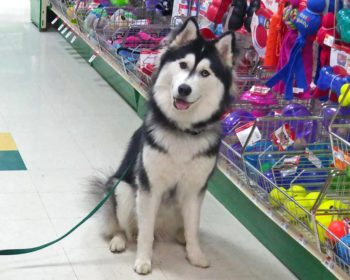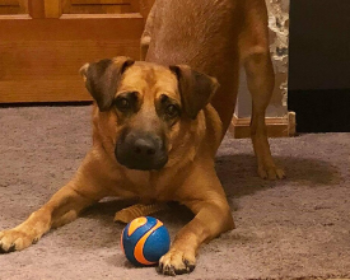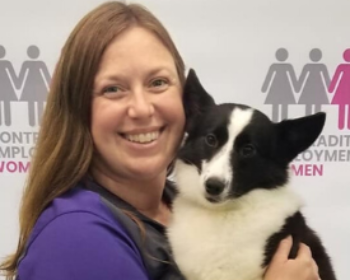Ten Steps to Prepare Your Dog for the New Baby
Your dog has been by your side for years. Her wet nose and wagging tail have helped you through the ups and downs of life. But now there’s a huge change on the horizon… you’re expecting a baby.
As much as you love your dog, you realize that she might not be trustworthy around a newborn. Or worse, what if she resents the baby because you don’t have as much time for puppy play as you used to? We have all known new parents who feel forced to relocate their beloved canine after a baby’s born. It’s hard on everyone involved when a spoiled pet suddenly becomes a permanent resident of the backyard or has to be surrendered to a shelter. There is another way! With some planning and preparation, your dog can integrate well with your new, growing family.
First thing’s first, this blog is meant to be a helpful guide and does not offer the same individual, specific advice that can be offered in a consultation with a qualified dog trainer. If your dog is already showing aggression or has bitten someone, please seek the assistance of a qualified trainer.
Before the Baby is Born
- Enroll in obedience training. A trainer will take your needs and your dog’s personality into consideration before recommending either group classes or
 private lessons. For the safety of the baby (and for your sanity) your dog should perform the following commands reliably: sit, come, loose leash walk (or heel), place, and off. In this situation it’s important to remember that obedience is not a parlor trick, but a new way of life. Always choose a trainer who listens to your goals and has a plan to help you get there.
private lessons. For the safety of the baby (and for your sanity) your dog should perform the following commands reliably: sit, come, loose leash walk (or heel), place, and off. In this situation it’s important to remember that obedience is not a parlor trick, but a new way of life. Always choose a trainer who listens to your goals and has a plan to help you get there. - Teach your dog to hold her “place.” Place is basically a dog bed that acts like a crate without walls. When your dog is told to “place” she is allowed to sit, stand, lie down, chew a bone, or take a nap as long as she stays on the dog bed. This command is invaluable for keeping your dog near the family while knowing that she is contained and will not jump on the high chair or snatch the baby’s rattle. You can even get creative and have a “place” in each room.
- Get your dog accustomed to less attention. Let’s face it, soon you won’t be able to drop everything for a game of tug when the dog brings you her rope. Attention should happen on your terms, not on the dog’s. Stop petting your dog every time she solicits it. Petting and playing with your dog less now is an adjustment. However, getting used to this new treatment will lessen the chance that the dog will “resent” the new baby.
- Carefully consider what will be off-limits and start training now. Will the dog be allowed in the nursery? Will she be allowed near the baby swing? Will she be allowed on the couch? Now is the time to make these decisions and start enforcing the new rules. Sometimes it helps to block off prohibited rooms with a baby gate. Again, any changes (such as a new no-couch rule) should be enforced long before the baby arrives to prevent the dog connecting “not nice” rules with the new arrival.
- Desensitize your dog to baby sounds, sights, and smells. There are several CDs on the market that have baby sounds such as cooing, crying, and noisy toys. Desensitize your dog to these strange noises by playing the CD softly in the house and gradually turning up the volume. Use your imagination to expose your dog to as many baby sounds, sights, and smells as you can. Spend a few weeks rubbing baby lotion and baby powder on yourself. Carry a doll around the house and talk to it. All of these things will help your dog adjust when the little one arrives.
After the Baby Arrives
- Don’t coddle your dog’s fears and anxieties. If your dog seems upset (pacing, sulking, etc.) do not coddle her. You simply can’t reason with a dog. Petting her and saying, “It’s OK. Mommy still loves you, too,” while she’s in a negative state of mind is actually reinforcing the dog’s impression that there’s something to be worried about. Instead, praise your dog when she’s relaxed and use your obedience training. If she’s hiding under the end table, tell her “come-sit” then give her praise for following the commands. Do not praise her for hiding under the table.
 Give your dog a safe zone. It’s always important for a dog to have a calm den-type area. However, in an increasingly hectic household it becomes increasingly important. A crate with a blanket laid over the top works well for most dogs. When the baby becomes mobile, remember that the dog must have a place to get away.
Give your dog a safe zone. It’s always important for a dog to have a calm den-type area. However, in an increasingly hectic household it becomes increasingly important. A crate with a blanket laid over the top works well for most dogs. When the baby becomes mobile, remember that the dog must have a place to get away.- Continue your dog’s routine. As much as possible continue your dog’s daily walks, a consistent feeding schedule, etc. Put aside a little time each day (maybe while the baby’s napping) to shower your dog with affection whether it’s a game of fetch or a good belly rub. Now that your dog has learned how to walk nicely on a leash, it shouldn’t be a problem to take both her and the baby stroller. Make it a family outing!
- Show your dog that the baby’s a good thing. Teach her that politely sniffing or calmly sitting near the baby earn her praise and maybe even a treat. Avoid yelling at your dog to get away from the baby, as this might make the dog think of the baby as something to be feared or resented. Instead of yelling, use your obedience commands to gain control.
- SUPERVISE! No matter how well behaved your dog is, she’s still a dog. Never leave your dog and your baby together unsupervised. If your dog is near the baby, make sure that an adult’s hand is within six inches just incase something goes awry.
Remember, most dogs are happy to follow the rules if they know what the rules are. Our challenge is communicate the rules by being clear and consistent. If you follow these ten tips and embrace the theory behind them, you are well on your way to a harmonious home.




